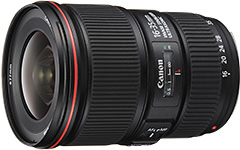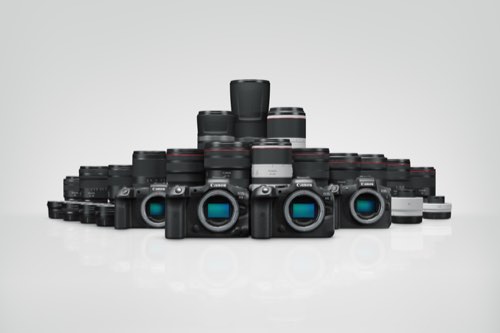[Part 2] The Latest Wide-angle Zoom Technologies Canon Takes Pride in EF16-35mm f/4L IS USM & EF-S10-18mm f/4.5-5.6 IS STM
In 2014, Canon has put in much effort to enhance the lineup of its interchangeable lenses, which includes the successive launch of two wide-angle lenses, the EF16-35mm f/4L IS USM and the EF-S10-18mm f/4.5-5.6 IS STM. In this article, I will go to the core of the technologies found on the latest lenses, which have a different focal length and maximum aperture value from other existing lenses.(Reported by: Junichi Date)

Pages: 1 2

Photos (left to right)
Shota Shimada: ICP Group 1, Image Communication Products Operations, CANON INC./ Kunihiko Sasaki: ICP Development Center 1, Image Communication Products Operations, CANON INC./ Shunji Iwamoto: ICP Development Center 1, Image Communication Products Operations, CANON INC./ Makoto Nakahara: ICP Development Center 1,Image Communication Products Operations, CANON INC./ Masayasu Mizushima: Camera Development Center/ Masami Sugimori, ICP Development Center 1, Image Communication Products Operations, CANON INC.
EF-S10-18mm Made Possible with the Production Technology for Plastic Moulded Aspherical Lens
― Next, I would like to know more about the EF-S10-18mm f/4.5-5.6 IS STM. The pricing is very reasonable. What is the aim of releasing this lens?
Shimada We have been planning to recommend users to get an ultra wide-angle lens as the next kit lens after purchasing the standard zoom or double zoom kit. According to a survey we have conducted, about 40 to 50% of our customers who have purchased the kit lens end up using only that lens. Despite their debut as a DSLR user, it is a waste not being able to fully enjoy using different interchangeable lenses. Hence, this lens is introduced to help broaden our users' scope of photographic expression. In the survey, we also found out that users did not progress further from the kit lens. Because many find it difficult to distinguish the differences in the image captured by a kit lens and that by other lenses. Another reason was that interchangeable lenses were too costly. This is why we decided to release an ultra wide-angle lens with a focal length equivalent to 16mm in the 35mm format, which is more affordable compared to conventional interchangeable lenses, while the compact size and light weight balance well with entry-level DSLR models. Not only so, it allows users to enjoy new styles of photographic expression that is fundamentally different from their kit lens.
― Doesn't it clash with the existing EF-S10-22mm f/3.5-4.5 USM?
Shimada The EF-S10-22mm f/3.5-4.5 USM has a focal length of 22mm at the telephoto end, which overlaps considerably with that of the standard zoom. Besides, it comes with a focus scale, and takes on an elegant appearance. Though not built in with the IS feature, the maximum aperture of f/3.5-4.5 is about 1/3- to 2/3-stop brighter. The more experienced users will tend to place importance on these aspects.
― Which one of them has a better image quality?
Nakahara As you can tell from the MTF characteristics, the EF-S10-18mm f/4.5-5.6 IS STM boasts higher performance despite its reasonable pricing, partly because of the lower maximum aperture value. An aspherical lens element is placed both at the front and at the rear of the optical system to reduce field curvature, distortions, and spherical aberrations. At the same time, UD lens elements are also effectively employed in the design to suppress chromatic aberrations.
― One of my concerns is the plastic mount. Is it durable enough?
Mizushima We are often asked the same question. The lens makes use of a material (highly-functional engineering plastic) that has excellent durability in terms of shock and wear resistance. It has cleared the tests that we conducted in-house, proving that it is safe to use.
― If that is the case, why do you still adopt a metal mount for the other lenses?
Mizushima The strength required of the mount varies depending on the size and weight of the lens it needs to support. For heavy lenses such as a super telephoto or large-diameter lens, a metal mount would be a better choice in terms of strength. The EF-S10-18mm f/4.5-5.6 IS STM, however, is very light in weight, which is why we decided that a plastic mount would be able to provide the necessary amount of strength.

Size and Weight of 2 Wide-angle EF-S Lenses
Adopting a design with a narrower angle of view and lower maximum aperture at the telephoto end, and employing plastic moulded aspherical lens elements as well as a plastic mount, this lens is compact, lightweight, and reasonably priced. This ultra wide-angle lens is affordable even for light users.
― What are the key points in the technologies for achieving the optical design of the EF-S10-18mm f/4.5-5.6 IS STM?
Nakahara The characteristic about this lens is the using a plastic, large-diameter aspherical lens as the second element from the front, which contributes to the lightweight and reasonable price of the lens, while enhancing the image quality markedly at the same time. We have adopted plastic moulded aspherical lens elements with a small diameter in the past, but the one on the EF-S10-18mm f/4.5-5.6 IS STM has a very large diameter. To achieve this, we needed to clear stringent quality standards, a challenge which we could not overcome in the past. It is therefore not an overstatement to say that the commercialisation of the EF-S10-18mm f/4.5-5.6 IS STM is possible, thanks to the establishment of the technology for producing large-diameter plastic moulded aspherical lenses. Additionally, taking into consideration its use for movie recording, an STM has been used to ensure quiet and smooth AF. We have also adopted a design that minimises fluctuations in the image magnification during focusing.
― I see. So, breakthroughs in the production technology for aspherical lenses are the key to the commercialisation of both the EF16-35mm f/4L IS USM and the EF-S10-18mm f/4.5-5.6 IS STM.
Ending Remarks
Double-sided Aspherical Lenses Form the Foundation for the Optical Technology of Future Wide-angle Lenses
Comparatively, I prefer APS-C size cameras to full-frame ones, but I still haven't found a real, professional APS-C model. Currently, I make use of the EOS 5D Mark III most of the time, which excels in high ISO speed shots and offers enhanced AF and continuous shooting performance.
However, I am always at a loss when it comes to choosing an ultra wide-angle lens. Unfortunately, I still can't find one that has a satisfactory level of peripheral image quality among the existing EF lenses, so I have been taking ultra wide-angle shots mainly with a mirrorless APS-C format model. In fact, the recent ultra wide-angle lenses for mirrorless cameras offer extremely high peripheral image quality. On top of that, they also come with the IS feature and are reasonably priced. Though it uses digital correction, distortions are effectively corrected.
Taking such circumstances into consideration, it is inevitable that my assessment of the EF16-35mm f/4L IS USM would be rather harsh. After trying it out, however, I found out that the peripheral image quality is very stable, as described in the catalogue, and it provides reassuring support for photographing when the aperture is fully open. If we compare it with the lens construction of the existing EF16-35mm f/2.8L II USM, we can tell that there isn't much difference except for the addition of the IS unit.
This prompted me to explore the factors contributing to the enhanced peripheral image quality in this interview. It seems that the adoption of a double-sided aspherical lens element has contributed greatly to striking a balance between the contradictory properties of field curvature and distortion at a high level. The reasons for the high peripheral image quality of ultra wide-angle lenses for mirrorless cameras can be attributed not only to the advantage of a short back focus for wide-angle lenses, but also because efforts are devoted to correcting field curvature with distortions corrected digitally. In contrast, digital corrections are not reflected in the viewfinder in the case of SLR lenses, so distortions have to be corrected optically. The key to achieving this lies in the use of double-sided aspherical lenses and the enhancement in their production technology.


Click here to see details of the EF-S10-18mm f/4.5-5.6 IS STM

Born in Hiroshima in 1962. Graduated from the Department of Image Science, Faculty of Engineering, Chiba University. Besides his career as a photographer such as for magazines, Date is also involved actively in writing using his expertise.

A monthly magazine that believes that enjoyment of photography will increase the more one learns about camera functions. It delivers news on the latest cameras and features and regularly introduces various photography techniques.
Published by Impress Corporation

































